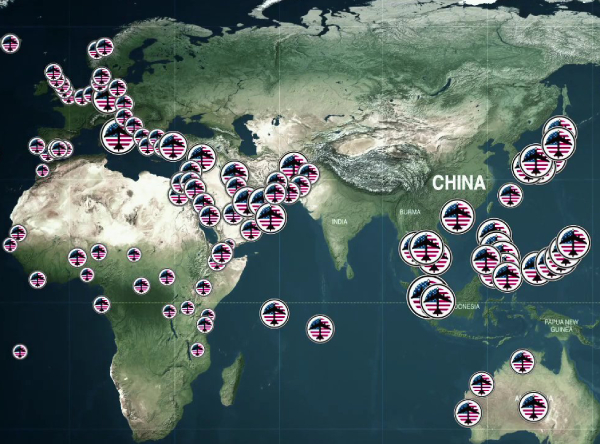Most Americans believe that the present war in Ukraine started with the Russian invasion in February 2022. But it’s important to look at just why the Russians invaded. It was not just the old false meme of “Russian aggression” as Biden, Blinken, Hillary Clinton and the rest of the neoconservative Russophobes would have you believe.
Russia has not sought to control any of the countries on its western border since the Soviet Union collapsed in late 1991, during the liberalizing presidency of Vladimir Putin’s mentor, Mikhail Gorbachev. Gorbachev had wanted to maintain the Union in looser form with the various soviet republics mainly self-governing. That would be something like the American Confederacy of the Civil War era, as opposed to the federally organized Union. But it was not to be, as the previous Soviet client states sought and gained complete independence. Hence, Russia went back essentially to its pre-Soviet boundaries, which was still a giant state occupying some one-sixth of the world. But it lacks the power of the Soviet Union in world politics. And Russian decline has in turn emboldened the United States to become more aggressive.
The war in Ukraine then was not caused by Russian would-be expansionism. On the contrary, it was the result of the U. S., several thousands of miles away, surrounding a weakened Russian state with the goal of choking it off from its neighbors and ultimately dismembering it. U. S. policy was to do everything it could to weaken its old Cold War rival in order to make itself “the sole superpower.” In that endeavor, intensified American fifth column meddling in Russian affairs began in the Eighties, when an alcohol compromised Boris Yeltsin hastened Russian decline and U. S. ascendancy. The Nixon and Carter administrations both had supported détente with the Soviet Union. Reagan came into the presidency in 1981 with bellicose speeches referring to Russia as “the evil empire.” But when Gorbachev offered to restart arms control, which had lain dormant since the Nixon era, Reagan accepted the offer, and their subsequent talks led to the Intermediate Nuclear Forces (INF) treaty. Reagan had been very much a cold warrior, but unlike the neocons, who were soon to undo détente, he sincerely wanted to come to an agreement with Moscow that would much lessen the chances of a third world war.
The neocons, on the other hand, were all about weakening Russia, as well as China, so that the U. S. would dominate the world as its one superpower. That is what seemed at last to be possible in the period of what looked to the West like Russian decline. But Russia would recover as Putin effectively reorganized it, recentralizing power and eliminating that of economic oligarchs, whose robber baron activities had compromised the Russian state. Many of the neocons were heavily invested in oil, and during the administration of George W. Bush, an oil man himself, this element made war in Iraq and Afghanistan, so as to project American power in the Middle East and South Asia. These wars brought the American military into that part of the world, where they are now dug in with several bases, just below Russia.
The U. S. also has bases all over Europe, from which together with the ones in the Middle East, they can project power against Russia. This brings us to Ukraine, formerly a part of the Soviet Union on its Eastern European border. Sitting thus on the Russian doorstep, Ukraine encompasses what Putin calls one of his red lines. The West, led by the U. S. under the influence of the neocons, has an established policy of surrounding Russia with bases. This has been a sharp departure from Reagan’s détente. A new American imperialism directly in the face of Russia has indeed become the neocon designed American policy. Neocon insistence on expanding the American military presence in both Europe and Asia have now made these regions less stable as the potential for hot war grows with Russia, and China. In fact, the new U. S. imperialism has now driven these two Great Powers together in alliance against Western aggression. This violates the doctrine Henry Kissinger developed in the Nixon administration to always keep Russia from joining with China against the West. Ukraine has become a stepping-stone in this new aggressive American posture. The neocon mode of operation in Europe is to subvert governments friendly to Russia on its border. In order to accomplish this end, they make use of the CIA and a new imperialistic entity created by the neocons called the National Endowment for Democracy
The CIA and NED accomplished what they call “color revolutions,” really U. S. backed coups, in countries on the Russian border: Georgia and Ukraine. The Russians went to war in Georgia and ended up recognizing two provinces as independent “statelets”: South Ossetia and Abkhazia, both with sizable Russian bases there. U. S. subversion of the Ukrainian government next led to a 2014 coup in that country. Thus began the campaign to capture a strategically placed state within the Russian orbit and draw it within the Western configuration. Putin has recognized the U. S. goal of tearing away states friendly to Russia on her border to instead become part of the American led alliance system. The neocons’ purpose is to surround Russia with states that have become part of the Western configuration. They also seek to do so with China, and the U. S. in that eventual endeavor has warships operating in the South China Sea.
The neoconservatives seek to spread their goal of American world domination within both political parties, and they have had some success in doing so, particularly among the Democrats, where neocons like President Joe Biden and Hillary Clinton, together with many policy operatives like Antony Blinken and Victoria Nuland now exert a great preeminent influence. Peace oriented Democrats have been marginalized or even pushed out of the party. Tulsi Gabbard, former congresswoman from Hawaii, and one of the few in national politics who served in the military and remains a reserve officer, is another war critic. Many Republicans, like minority leader, Mitch McConnell, generally support the new, Russophobic wars. But others, like presidential aspirant Ron de Santis, are sharply critical. With the exception of the Bushes, Republican leaders have been more loath to get the country into wars. Donald Trump, still very popular among Republicans, attained the presidency running against the endless foreign wars. So we have the more conservative party now more critical of wars and the more liberal one beating the drums for them.
All of this does not augur well for establishing a more peaceful, less conflict-ridden world. The War Democrats have now led us back to the aggressive posture their political forebears embraced during the Sixties. At that time, however, the American aggressive stance was more in what used to be called Third World countries like Vietnam, as well as Latin America, which politicos commonly referred to as “our backyard.” One thing that Cold War presidents like Kennedy, Johnson and Nixon strenuously avoided was confrontation with Russia and China. That generation had lived through the Second World War and had a keen sense of the horrors of modern warfare, all the way to Hiroshima and Nagasaki. But most of today’s American leaders have not experienced war. It’s the few who have, like Gabbard, having served in Iraq, who are most anxious to avoid it.
The present tense situation in Ukraine has caused many of our more thoughtful leaders to worry about a head-on confrontation with Russia. The Russians in turn are drawing ever closer to China. For its part, China will soon surpass the U. S. in economic and military power. The Chinese government also considers American ally, Taiwan, as part of China. That is another possible source of world war. At the same time, precious little is transpiring diplomatically between the U. S. and Russia as well as the U. S. and China. In the Sixties and Seventies negotiations commonly occurred between the U. S. and Russia. Thus regional wars like Vietnam did not turn into broader ones. Nixon and Kissinger opened negotiations with China and carried on regular ones with the Soviet Union. And those were communist countries, supposedly our implacable enemies. China still has a communist government, though their economy is very much a part of the capitalist world. And yet diplomatic contact is at a low ebb, far less than during the Cold War. If there is little but formal contact and important negotiations do not occur, then the prospect of world war grows, especially given situations like that in Ukraine and that in Taiwan.
Author
Stephen Berk (B.A. Lehigh University; M.A. University of Massachusetts, Amherst; Ph.D. University of Iowa) is emeritus professor of history at California State University Long Beach. He also holds a Master of Science in Counseling from Cal. State Long Beach. He taught at Cal. State Long Beach in the history department from 1970-2004). He worked as a CA licensed psychotherapist in private practice from 1982-2004. Now retired, he writes occasional opinion pieces for periodicals, and lives in the Boston, MA area, near where he grew up.
Comments
Another great article, Steve! Keep writing! Thanks TLA for hosting Steve’s writing! --Bob Goldberg



